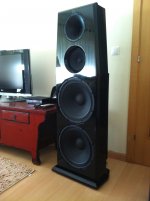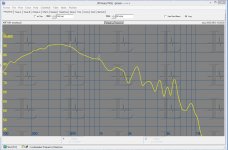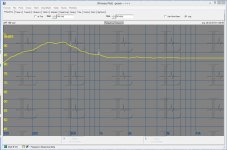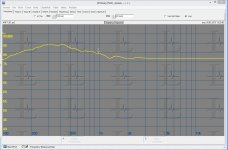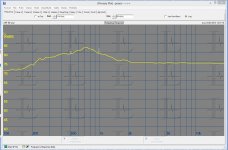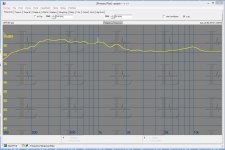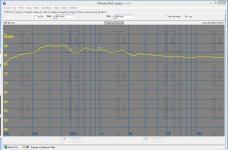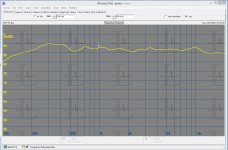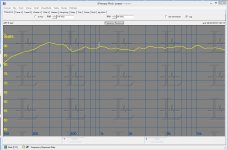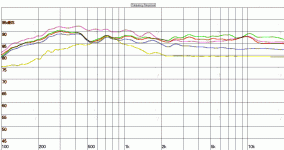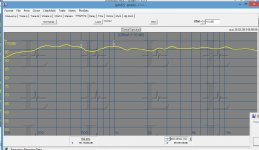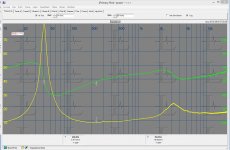Yeh, i had the same problem for many years.
Problem was that despite the hole i got good sound out of open baffles so I thought that it was my measurement method. That was obviously not the case.
So maybe one year ago a started to look into alternatives. Because i want to use the open baffle down to 100Hz the first idea was to reduce the width from 1.2 meters to 0.6 meters
and blend in a second 20 cm unit softly under say 500 Hz. That solved part of the problem and the notch got a bit smaller because the radiation area is now split vertically.
On the other hand the panel draws now double the current in the deeper regions because there the two drivers are in parallel so the impedance goes down in half. The Acoustic Resistance Frame ( i coined that name ) solves both of that problems, sounds better and goes as load and deep. I am quite enthusiastic about it actually.
Problem was that despite the hole i got good sound out of open baffles so I thought that it was my measurement method. That was obviously not the case.
So maybe one year ago a started to look into alternatives. Because i want to use the open baffle down to 100Hz the first idea was to reduce the width from 1.2 meters to 0.6 meters
and blend in a second 20 cm unit softly under say 500 Hz. That solved part of the problem and the notch got a bit smaller because the radiation area is now split vertically.
On the other hand the panel draws now double the current in the deeper regions because there the two drivers are in parallel so the impedance goes down in half. The Acoustic Resistance Frame ( i coined that name ) solves both of that problems, sounds better and goes as load and deep. I am quite enthusiastic about it actually.
I can't quite see a baffle-related reason for a hole at 300-400 Hz. Linkwitz surely doesn't give a hint at it too. Obvious is the first floor reflection of a driver at about 1 m height which will burn such a hole into the frequency response (if measured with the speaker standing on the floor of course).In my case i got a hole centered at around 300 - 400Hz that disappeared with the right amount of damping on the back of the frame.
So I'm looking forward to your measurements. I believe you will tell about the measurement conditions too.
Thank you for the Panzerholz link! I would never have imagined on what precious material I set my feet when entering an ICE. Is it things like this which make those trains that pricey?
Rudolf
Here are the measurements i made on the Acoustic Resistance Frame.
It is on 0°, 15°, 45°, 60°, 90°, 120°, 180°. I use a post process from Don Keele called
" Central Spectrum ". It works with the notion that the human ear hears peaks in the response better then holes or sharp notches. You see that on some off axis plots the response flattens in the treble. This is the consewquence that level is so low there that masking sets in and the frontal radiation dominates. The last plot shows the 180° response without that post process. The roll off is rather smooth i think.
It is on 0°, 15°, 45°, 60°, 90°, 120°, 180°. I use a post process from Don Keele called
" Central Spectrum ". It works with the notion that the human ear hears peaks in the response better then holes or sharp notches. You see that on some off axis plots the response flattens in the treble. This is the consewquence that level is so low there that masking sets in and the frontal radiation dominates. The last plot shows the 180° response without that post process. The roll off is rather smooth i think.
Attachments
You compiled the data old man, cool !!!!
Making the baffle slimmer until it disappears ?????
Making it 2 times as wide as the width of the radiating element ala. Lampedakis ?
By the way, i am in no struggle and i told you more the ones : come over and listen to that animal.
Making the baffle slimmer until it disappears ?????
Making it 2 times as wide as the width of the radiating element ala. Lampedakis ?
By the way, i am in no struggle and i told you more the ones : come over and listen to that animal.
The subjective result of this incarnation is extraordinary. One that witnessed the development to find an optimum platform for the Enviee is Holger Barske.
He visited me 3 times over the last 2 years and this is a report of the version that had the "helper" bass :
Visionen aus dem Hause Gerhard | Holger Barske
You can say : This is a journalist and the report is political.
In this case it can not be. This is Holgers privat web page and i did not put any advertising in his magazines the last 4 years. I did not even give anything out to ANY magazine the last 4 years. This is a labour of love.
He visited me 3 times over the last 2 years and this is a report of the version that had the "helper" bass :
Visionen aus dem Hause Gerhard | Holger Barske
You can say : This is a journalist and the report is political.
In this case it can not be. This is Holgers privat web page and i did not put any advertising in his magazines the last 4 years. I did not even give anything out to ANY magazine the last 4 years. This is a labour of love.
The measurements so far may tell us about tonal balance and radiation pattern.
An outstanding design like this has other properties that are important for success as well.
So far the measurements where taken with 1V in 1M. That is the default setting of my Praxis measurement system. I have repeated the on axis measurement with the more usual 2.83V at 1M. That transfers to 1W/1M into 8 Ohm. This gives a reading of 9.03dB more. I took the baffle as reference distance and got a sensitivity of 96.5dB at 2.83V. You can also see the impedance curve. The maximum is at 78.45 Ohm @ 40.37 Hz, the minimum is at 8.59 Ohm @ 238.2 Hz.
The fundamental resonance is shifted down a bit by the frame damping compared to the data sheet. The impedance curve reflexes my inbuild EQ. It is done with 3 passive components to reduce a slight upper presence lift that is the natural behaviour of the untreared driver. Some guests i had prefered the sound without EQ. It sounds somewhat more bouncy and dynamic to some but i prefer the even sound of my EQ and do not feel a loss of micro detail or dynamics. I think it is a psycho acoustic effect because a little lift in the upper presence gives that impression.
An outstanding design like this has other properties that are important for success as well.
So far the measurements where taken with 1V in 1M. That is the default setting of my Praxis measurement system. I have repeated the on axis measurement with the more usual 2.83V at 1M. That transfers to 1W/1M into 8 Ohm. This gives a reading of 9.03dB more. I took the baffle as reference distance and got a sensitivity of 96.5dB at 2.83V. You can also see the impedance curve. The maximum is at 78.45 Ohm @ 40.37 Hz, the minimum is at 8.59 Ohm @ 238.2 Hz.
The fundamental resonance is shifted down a bit by the frame damping compared to the data sheet. The impedance curve reflexes my inbuild EQ. It is done with 3 passive components to reduce a slight upper presence lift that is the natural behaviour of the untreared driver. Some guests i had prefered the sound without EQ. It sounds somewhat more bouncy and dynamic to some but i prefer the even sound of my EQ and do not feel a loss of micro detail or dynamics. I think it is a psycho acoustic effect because a little lift in the upper presence gives that impression.
